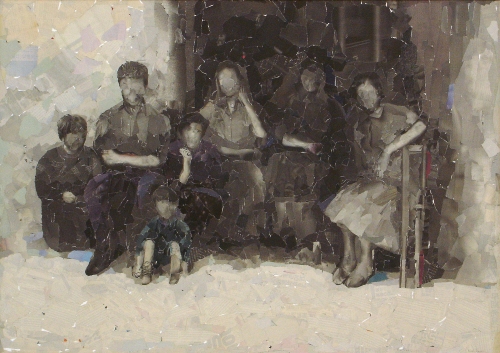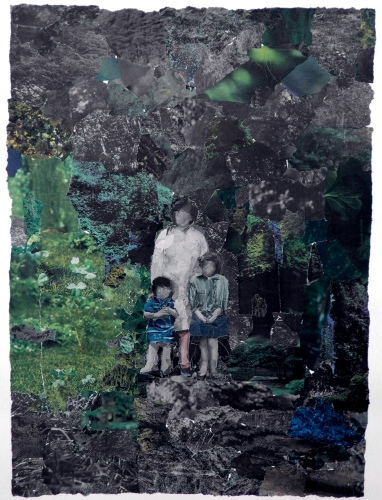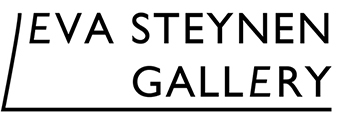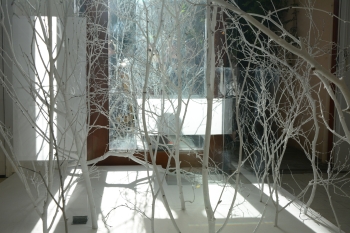%20Kopie_938A%20Short%20story%20about%20a%20room%20(a6)%20Kopie.JPG)

Marieke Van Wuytswinkel (1987) is an artist who works in a variety of media. With a conceptual approach, Van Wuytswinkel wants to amplify the astonishment of the spectator by creating compositions or settings that generate tranquil poetic images that leave traces and balances on the edge of recognition and alienation.
Her artworks appears as dreamlike images in which fiction and reality meet, well-known tropes merge, meanings shift, past and present fuse. Time and memory always play a key role. By questioning the concept of movement, she finds that movement reveals an inherent awkwardness, a humour that echoes our own vulnerabilities. The artist also considers movement as a metaphor for the ever-seeking man who experiences a continuous loss.
Her works directly respond to the surrounding environment and uses everyday experiences from the artist as a starting point. Often these are framed instances that would go unnoticed in their original context. By applying a poetic and often metaphorical language, she tries to approach a wide scale of subjects in a multi-layered way, likes to involve the viewer in a way that is sometimes physical and believes in the idea of function following form in a work.
Her works isolate the movements of humans and/or objects. By doing so, new sequences are created which reveal an inseparable relationship between motion and sound. Marieke Van Wuytswinkel currently lives and works in Brussels.
THE LAKE WASN’T THERE WHERE IT USUALLY WAS … (INSTALLATIE, 2015)
“I saw that there was no Nature; that Nature does not exist; that there are mountains, valleys, plains; that there are trees, flowers, grasses; that there are streams and stones; but that there’s not a whole to which this belongs. That a real and true ensemble is a disease of our ideas.
Nature is parts without a whole. This perhaps is that mystery they speak of.” (Fernando Pessoa, Poemas de Alberto Caeiro)
‘The lake wasn’t there where it usually was…’ vertrekt van een schijnbare herinnering aan een moment. De installatie bestaat uit een verhaal, een collage en een in situ-installatie. Gedurende de tentoonstelling zal de volledige installatie verschillende malen veranderen, net zoals een herinnering er steeds anders uitziet – andere focussen, vervagende elementen en verscheidene herinneringen die zich mengen.
Het werk bevraagt de grenzen van ons geheugen en de processen van het opslaan en oproepen van herinneringen.
‘The lake wasn’t there where it usually was…’ bewandelt de grens tussen fictie en realiteit. De installatie maakt onderdeel uit van het project ‘Documents of a False Memory’. Dit project startte in 2013 met de video ‘Sculpting Memory’. De video ‘A Short Story about a Room’ (2014) maakt tevens onderdeel uit van dit project. ‘Documents of a False Memory’ onderzoekt het misleidende karakter van het visuele geheugen en de rol van geheugenbeelden.
SCULPTING MEMORY (VIDEO, 2013, 14’35”)
“In the end, it is an exercise to stick to images when they emerge. They still fade after a twenty-fourth of a second, the length of a film frame.” (excerpt from Chris Markers ‘Sans Soleil’, 1983)
Het videowerk vertrekt vanuit een selectie uit een verzameling foto’s van Kronstadt, Sint-Petersburg. De selectie is willekeurig, de afbeeldingen banaal. Het zijn foto’s van locaties zonder inwoners.
Door deze beelden gedetailleerd te onderzoeken, te tekenen en dit proces steeds te herhalen, probeer ik mijn herinneringen aan Kronstadt te manipuleren en nieuwe geheugenbeelden creëren.
Het proces zou ik omschrijven als het ‘boetseren van tijd’ (‘sculpting time’) of het ‘beeldhouwen van geheugen’ (‘sculpting memory’).
Deze video werd gemaakt gedurende mijn residentie aan het NCCA, Kronstadt, Sint-Petersburg.
A SHORT STORY ABOUT A ROOM (VIDEO, 2014, 13’44”)
The movie tells the story of a room. In this room the traces of the existence of its occupants were safely stored. The room got empty recently. One of the habitants tried to safe and reconstruct the moments that were spend in it. This reconstruction creates the reverse effect: the room starts losing the traces of time and space to which it was linked. It discovers a time and space that lies beyond the borders of the building and the image.
The movie talks about a room as a symbol of memory of our existence. It questions processes of storing memories, the borders of a space - of a real space but also of the space of an image. The movie explores the way our memory is influenced by photography and the influence of travelling to the access and construction of memory.

Syunsaku Hishikari (1952), peintre et artiste connu pour son travail en trois dimensions, réalise depuis quelques années des collages en utilisant de vieux journaux pour reconstituer à sa manière des « peintures ». Son thème principal est le portrait de groupe pris à l’occasion de soirées, de réunions ou de vacances au début surtout en noire et blanc.
Les visages représentés dans ces portraits, comme s’ils avaient été exposés trop longtemps, ne sont pas reconnaissables. Ces images anonymes permettent au spectateur de se projeter plus facilement dedans et d’identifier les personnes représentées comme étant des proches ou des amis. Les images d’Hishikari semblent provenir de notre histoire personnelle.
Les caractères d’imprimerie qui transparaissent à travers les morceaux de journaux suscitent une irritation subtile. En effet, les vieux journaux révèlent le caractère éphémère des événements et leur propre anachronisme tandis que les portraits photographiques ont été fait pour retenir le temps présent et garder à la mémoire des moments de vie privée.
Chez Syunsaku Hishikari l’instant présent des photos souvenirs fusionne avec le temps révolu des vieux journaux. Le temps semble suspendu dans ces images.
L'artiste déchire des photos de journaux et magazines pour les transformer en de nouvelles images de peinture avec les moyens du collage.
Au départ, la photographie opère une abstraction de la réalité. Cette Abstraction prend ensuite tout son essor quand l'artiste déchire cette photographie en petits morceaux qu'il colle en recomposant une nouvelle image. Chaque portrait est crée à partir de plusieurs photographies de différents personnes. Hishikari fait surgir des portraits inexistants.
Le contraste étonnant entre le long et laborieux processus de travail et l'instantané des prises de vue qu'il exploite constitue une aventure délirante à travers l'expérience du temps.
Après l'impression d'une photographie, l'achat du journal, la lecture, le déchirage, le rangement, le repérage, il y a l'empilement de tas des petits morceaux de papiers dans toutes les nuances de gris et de couleurs différentes, telle une réserve de tubes de peinture.
Ensuite, l'artiste arrange pendant des semaines les morceaux de papier sur un support avant d'obtenir enfin.... une image.
Devant ces images, au premier abord, l’œil croit percevoir une photographie prise au 60ème de seconde sur pellicule. Plus précisément, une ancienne photographie qui, en proie à la lumière du soleil et d'autres actions de la nature aurait subi une détérioration naturelle pendant des années. Mais lorsqu'on s’approche, se dévoile une composition de différentes gammes de gris ou de couleurs. Et on comprend enfin qu'il s'agit en fait de collages (des journaux).
En parallèle à ses portraits-collages Hishikari réalise également des livres d’art uniques en utilisant la même technique de collage à partir de journaux et de magazines.
Wolfgang Dengel


%20-%20Still_1389Sculpting%20Memory%20(2013)%20-%20Still.JPG)